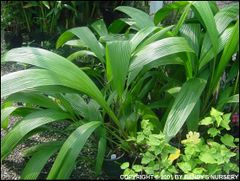Setaria: Difference between revisions
No edit summary |
No edit summary |
||
| Line 13: | Line 13: | ||
|image=Setaria palmifolia.jpg | |image=Setaria palmifolia.jpg | ||
|image_width=240 | |image_width=240 | ||
}} | }} | ||
{{Inc| | {{Inc| | ||
Setaria (Latin, seta, a bristle). Gramineae. Annual or sometimes perennial grasses with bristly spike-like panicles: spikelets as in Panicum, but subtended by 1 to several bristles that extend beyond the spikelet and persist after the spikelet falls: the fr., that is, the mature fertile floret, usually transversely wrinkled.— Species about 40 in the warmer regions of the world. Several species are annual weeds, such as Yellow Fox-tail (S. glauca, Beauv.) with oblong yellow spikes, and 5 or more bristles below each spikelet, and Green Fox-tail (S. viridis, Beauv.), with somewhat pointed green spikes and 1-3 bristles below each spikelet. Many American botanists use the name Chaetochloa instead of Setaria. (Dept. Agric., Div. Agrost., Bull. 21, is devoted to this genus.) The setarias are scarcely horticultural subjects, being primarily forage plants; but they are so widespread in cult. and the forms are so confused that a somewhat full discussion of them may be inserted here. | Setaria (Latin, seta, a bristle). Gramineae. Annual or sometimes perennial grasses with bristly spike-like panicles: spikelets as in Panicum, but subtended by 1 to several bristles that extend beyond the spikelet and persist after the spikelet falls: the fr., that is, the mature fertile floret, usually transversely wrinkled.— Species about 40 in the warmer regions of the world. Several species are annual weeds, such as Yellow Fox-tail (S. glauca, Beauv.) with oblong yellow spikes, and 5 or more bristles below each spikelet, and Green Fox-tail (S. viridis, Beauv.), with somewhat pointed green spikes and 1-3 bristles below each spikelet. Many American botanists use the name Chaetochloa instead of Setaria. (Dept. Agric., Div. Agrost., Bull. 21, is devoted to this genus.) The setarias are scarcely horticultural subjects, being primarily forage plants; but they are so widespread in cult. and the forms are so confused that a somewhat full discussion of them may be inserted here. | ||
{{SCH}} | {{SCH}} | ||
| Line 81: | Line 50: | ||
{{stub}} | {{stub}} | ||
__NOTOC__ | |||
Latest revision as of 16:28, 22 December 2009
| Setaria palmifolia subsp. var. | Palm Grass | |||||||||||||||||||||||||||||||||||||||||||||||||||||||
|---|---|---|---|---|---|---|---|---|---|---|---|---|---|---|---|---|---|---|---|---|---|---|---|---|---|---|---|---|---|---|---|---|---|---|---|---|---|---|---|---|---|---|---|---|---|---|---|---|---|---|---|---|---|---|---|---|

|
|
| ||||||||||||||||||||||||||||||||||||||||||||||||||||||
| ||||||||||||||||||||||||||||||||||||||||||||||||||||||||
| Standard Cyclopedia of Horticulture |
|---|
|
Setaria (Latin, seta, a bristle). Gramineae. Annual or sometimes perennial grasses with bristly spike-like panicles: spikelets as in Panicum, but subtended by 1 to several bristles that extend beyond the spikelet and persist after the spikelet falls: the fr., that is, the mature fertile floret, usually transversely wrinkled.— Species about 40 in the warmer regions of the world. Several species are annual weeds, such as Yellow Fox-tail (S. glauca, Beauv.) with oblong yellow spikes, and 5 or more bristles below each spikelet, and Green Fox-tail (S. viridis, Beauv.), with somewhat pointed green spikes and 1-3 bristles below each spikelet. Many American botanists use the name Chaetochloa instead of Setaria. (Dept. Agric., Div. Agrost., Bull. 21, is devoted to this genus.) The setarias are scarcely horticultural subjects, being primarily forage plants; but they are so widespread in cult. and the forms are so confused that a somewhat full discussion of them may be inserted here. CH
|
Cultivation
- Do you have cultivation info on this plant? Edit this section!
Propagation
- Do you have propagation info on this plant? Edit this section!
Pests and diseases
- Do you have pest and disease info on this plant? Edit this section!
Species
Gallery
If you have a photo of this plant, please upload it! Plus, there may be other photos available for you to add.
-
photo 1
-
photo 2
-
photo 3
References
- Standard Cyclopedia of Horticulture, by L. H. Bailey, MacMillan Co., 1963
External links
- w:Setaria. Some of the material on this page may be from Wikipedia, under the Creative Commons license.
- Setaria QR Code (Size 50, 100, 200, 500)
